Optimizing the Extraction of Protein from Defatted Schizochytrium Cell Residues and Studying the Emulsification Characteristics of Protein
Abstract
:1. Introduction
2. Materials and Methods
2.1. Materials and Reagents
2.2. Preparation of Defatted Schizochytrium Residues (DOS)
2.3. Preparation of Crude Protein of Schizochytrium (SCP)
2.3.1. Extraction of SCP and Determination of Extraction Rate
2.3.2. Single-Factor Experiments and Determination of Extraction Rate
2.3.3. Response Surface Analysis
2.4. Determination of Main Components
2.5. Study on the Properties of SCP Emulsions
2.5.1. Surface Tension
2.5.2. Emulsion Preparation
2.5.3. Protein Emulsifying Properties (EAI/ESI)
2.5.4. Average Particle Size of Emulsion
2.5.5. Creaming Index (CI)
2.5.6. Microstructure of Emulsions
2.6. Statistical Analyses
3. Results and Discussion
3.1. Optimization of SCP Extraction Process
3.1.1. Single-Factor Experiments
3.1.2. Results of Response Surface Test on the Extraction Rate of SCP
3.1.3. Isoelectric Precipitation
3.2. Study on Emulsification Properties of SCP
3.2.1. Interfacial Tension
3.2.2. Emulsifying Properties of SCP
3.2.3. Factors Affecting Emulsification Activity and Emulsion Stability of SCP
3.2.4. Droplet Size of Emulsion
3.2.5. Storage Stability of SCP Emulsions
4. Conclusions
Author Contributions
Funding
Institutional Review Board Statement
Informed Consent Statement
Data Availability Statement
Conflicts of Interest
References
- Meng, C.; Peng, B. Establishment of a high-throughput screening platform to screen Schizochytrium sp. with a high yield of DHA. Algal Res. 2023, 74, 103201. [Google Scholar] [CrossRef]
- Calder, P.C. Very long-chainn-3 fatty acids and human health: Fact, fiction and the future. Proc. Nutr. Soc. 2017, 77, 52–72. [Google Scholar] [CrossRef]
- Jia, Y.-L.; Zhang, Y.; Xu, L.-W.; Zhang, Z.-X.; Xu, Y.-S.; Ma, W.; Gu, Y.; Sun, X.-M. Enhanced fatty acid storage combined with the multi-factor optimization of fermentation for high-level production of docosahexaenoic acid in Schizochytrium sp. Bioresour. Technol. 2024, 398, 130532. [Google Scholar] [CrossRef]
- Patra, A.; Arun Prasath, V. Isolation of detoxified cassava (Manihot esculenta L.) leaf protein by alkaline extraction-isoelectric precipitation: Optimization and its characterization. Food Chem. 2024, 437, 137845. [Google Scholar] [CrossRef]
- Wang, S.; Miao, S.; Sun, D.-W. Modifying structural and techno-functional properties of quinoa proteins through extraction techniques and modification methods. Trends Food Sci. Technol. 2024, 143, 104285. [Google Scholar] [CrossRef]
- Fang, B.; Chang, L.; Ohm, J.-B.; Chen, B.; Rao, J. Structural, functional properties, and volatile profile of hemp protein isolate as affected by extraction method: Alkaline extraction–isoelectric precipitation vs salt extraction. Food Chem. 2023, 405, 135001. [Google Scholar] [CrossRef]
- Fan, X. Nutrient analysis and optimization of protein extraction process of the algal sludge of Pseudomonas sp. J. Process Eng. 2015, 15, 126–131. [Google Scholar]
- McHardy, C.; Djike Kammegne, T.; Jänich, I. Energy-efficient ultrasound-assisted extraction of food proteins from the microalga C. vulgaris at elevated static pressure. Innov. Food Sci. Emerg. 2021, 73, 102797. [Google Scholar] [CrossRef]
- Yan, H.; Zou, H.; Li, S.; Sun, S.; Xu, Q.; Yu, C. Modification of functional properties of mussel actomyosin by ultrasound treatment and the appplication at O/W emulsion. LWT 2022, 170, 114086. [Google Scholar] [CrossRef]
- Resendiz-Vazquez, J.A.; Ulloa, J.A.; Urías-Silvas, J.E.; Bautista-Rosales, P.U.; Ramírez-Ramírez, J.C.; Rosas-Ulloa, P.; González-Torres, L. Effect of high-intensity ultrasound on the technofunctional properties and structure of jackfruit (Artocarpus heterophyllus) seed protein isolate. Ultrason. Sonochem. 2017, 37, 436–444. [Google Scholar] [CrossRef]
- Cuesta, G.; Suarez, N.; Bessio, M.I.; Ferreira, F.; Massaldi, H. Quantitative determination of pneumococcal capsular polysaccharide serotype 14 using a modification of phenol–sulfuric acid method. J. Microbiol. 2003, 52, 69–73. [Google Scholar] [CrossRef] [PubMed]
- de Souza, T.S.P.; Dias, F.F.G.; Koblitz, M.G.B.; de Moura Bell, J.M.L.N. Effects of enzymatic extraction of oil and protein from almond cake on the physicochemical and functional properties of protein extracts. Food Bioprod. Process. 2020, 122, 280–290. [Google Scholar] [CrossRef]
- Zhang, X.; Wang, Q.; Liu, Z.; Zhi, L.; Jiao, B.; Hu, H.; Ma, X.; Agyei, D.; Shi, A. Plant protein-based emulsifiers: Mechanisms, techniques for emulsification enhancement and applications. Food Hydrocoll. 2023, 144, 109008. [Google Scholar] [CrossRef]
- Li, K.; Fu, L.; Zhao, Y.-Y.; Xue, S.-W.; Wang, P.; Xu, X.-L.; Bai, Y.-H. Use of high-intensity ultrasound to improve emulsifying properties of chicken myofibrillar protein and enhance the rheological properties and stability of the emulsion. Food Hydrocoll. 2020, 98, 105275. [Google Scholar] [CrossRef]
- Liang, H.-N.; Tang, C.-H. pH-dependent emulsifying properties of pea [Pisum sativum (L.)] proteins. Food Hydrocoll. 2013, 33, 309–319. [Google Scholar] [CrossRef]
- Kumar, M.; Tomar, M.; Potkule, J.; Reetu; Punia, S.; Dhakane-Lad, J.; Singh, S.; Dhumal, S.; Chandra Pradhan, P.; Bhushan, B.; et al. Functional characterization of plant-based protein to determine its quality for food applications. Food Hydrocoll. 2022, 123, 106986. [Google Scholar] [CrossRef]
- Hadidi, M.; Khaksar, F.B.; Pagan, J.; Ibarz, A. Application of Ultrasound-Ultrafiltration-Assisted alkaline isoelectric precipitation (UUAAIP) technique for producing alfalfa protein isolate for human consumption: Optimization, comparison, physicochemical, and functional properties. Food Res. Int. 2020, 130, 108907. [Google Scholar] [CrossRef]
- Vilg, J.V.; Undeland, I. pH-driven solubilization and isoelectric precipitation of proteins from the brown seaweed Saccharina latissima—Effects of osmotic shock, water volume and temperature. J. Appl. Phycol. 2017, 29, 585–593. [Google Scholar] [CrossRef]
- Luo, Q.; Li, X.; Zhang, Z.; Chen, A.; Li, S.; Shen, G.; Li, M.; Liu, X.; Yin, X.; Cheng, L.; et al. Extraction of Zanthoxylum seed protein and identification of its simulated digestion products. LWT 2022, 161, 113412. [Google Scholar] [CrossRef]
- Phusunti, N.; Cheirsilp, B. Integrated protein extraction with bio-oil production for microalgal biorefinery. Algal Res. 2020, 48, 101918. [Google Scholar] [CrossRef]
- Ursu, A.-V.; Marcati, A.; Sayd, T.; Sante-Lhoutellier, V.; Djelveh, G.; Michaud, P. Extraction, fractionation and functional properties of proteins from the microalgae Chlorella vulgaris. Bioresour. Technol. 2014, 157, 134–139. [Google Scholar] [CrossRef] [PubMed]
- Gao, Z.; Liu, K.; Chen, F. Optimization of extraction conditions for corn germ protein by Alkali Method. Food Ind. 2020, 41, 5–8. [Google Scholar]
- Schwenzfeier, A.; Wierenga, P.A.; Gruppen, H. Isolation and characterization of soluble protein from the green microalgae Tetraselmis sp. Bioresour. Technol. 2011, 102, 9121–9127. [Google Scholar] [CrossRef] [PubMed]
- Juel, N.; Juul, L.; Tanambell, H.; Dalsgaard, T.K. Extraction and purification of seaweed protein from Ulva sp.—Challenges to overcome. LWT 2024, 198, 115944. [Google Scholar] [CrossRef]
- Shi, T.; Cao, J.; Cao, J.; Zhu, F.; Cao, F.; Su, E. Almond (Amygdalus communis L.) kernel protein: A review on the extraction, functional properties and nutritional value. Food Res. Int. 2023, 167, 112721. [Google Scholar] [CrossRef]
- Benelhadj, S.; Gharsallaoui, A.; Degraeve, P.; Attia, H.; Ghorbel, D. Effect of pH on the functional properties of Arthrospira (Spirulina) platensis protein isolate. Food Chem. 2016, 194, 1056–1063. [Google Scholar] [CrossRef] [PubMed]
- Dickinson, E. Adsorbed protein layers at fluid interfaces: Interactions, structure and surface rheology. Colloids Surf. B 1999, 15, 161–176. [Google Scholar] [CrossRef]
- Karaca, A.C.; Low, N.; Nickerson, M. Emulsifying properties of chickpea, faba bean, lentil and pea proteins produced by isoelectric precipitation and salt extraction. Food Res. Int. 2011, 44, 2742–2750. [Google Scholar] [CrossRef]
- Zhao, Q.; Xie, T.; Hong, X.; Zhou, Y.; Fan, L.; Liu, Y.; Li, J. Modification of functional properties of perilla protein isolate by high-intensity ultrasonic treatment and the stability of o/w emulsion. Food Chem. 2022, 368, 130848. [Google Scholar] [CrossRef]
- Liu, G.; Hu, M.; Du, X.; Liao, Y.; Yan, S.; Zhang, S.; Qi, B.; Li, Y. Correlating structure and emulsification of soybean protein isolate: Synergism between low-pH-shifting treatment and ultrasonication improves emulsifying properties. Colloids Surf. 2022, 646, 128963. [Google Scholar] [CrossRef]
- Geerts, M.E.J.; Nikiforidis, C.V.; van der Goot, A.J.; van der Padt, A. Protein nativity explains emulsifying properties of aqueous extracted protein components from yellow pea. Food Struct. 2017, 14, 104–111. [Google Scholar] [CrossRef]
- Wu, C.; Zhang, Y.; Wang, J.; Xu, W.; Hu, Z.; Hu, C. Continuous enzyme crosslinking modifying colloidal particle characteristics and interface properties of rice bran protein to improve the foaming properties. LWT 2023, 184, 114997. [Google Scholar] [CrossRef]
- Xu, F.; Pan, M.; Li, J.; Ju, X.; Wu, J.; Cui, Z.; Wang, L. Preparation and characteristics of high internal phase emulsions stabilized by rapeseed protein isolate. LWT 2021, 149, 111753. [Google Scholar] [CrossRef]
- Jiang, J.; Chen, J.; Xiong, Y.L. Structural and Emulsifying Properties of Soy Protein Isolate Subjected to Acid and Alkaline pH-Shifting Processes. J. Agric. Food Chem. 2009, 57, 7576–7583. [Google Scholar] [CrossRef] [PubMed]
- Lv, P.; Wang, D.; Dai, L.; Wu, X.; Gao, Y.; Yuan, F. Pickering emulsion gels stabilized by high hydrostatic pressure-induced whey protein isolate gel particles: Characterization and encapsulation of curcumin. Food Res. Int. 2020, 132, 109032. [Google Scholar] [CrossRef] [PubMed]
- Dai, L.; Zhan, X.; Wei, Y.; Sun, C.; Mao, L.; McClements, D.J.; Gao, Y. Composite zein—Propylene glycol alginate particles prepared using solvent evaporation: Characterization and application as Pickering emulsion stabilizers. Food Hydrocoll. 2018, 85, 281–290. [Google Scholar] [CrossRef]
- Ozturk, B.; Argin, S.; Ozilgen, M.; McClements, D.J. Formation and stabilization of nanoemulsion-based vitamin E delivery systems using natural surfactants: Quillaja saponin and lecithin. J. Food Eng. 2014, 142, 57–63. [Google Scholar] [CrossRef]
- Wang, B.; Li, D.; Wang, L.-J.; Özkan, N. Effect of concentrated flaxseed protein on the stability and rheological properties of soybean oil-in-water emulsions. J. Food Eng. 2010, 96, 555–561. [Google Scholar] [CrossRef]
- Ye, F.; Miao, M.; Jiang, B.; Campanella, O.H.; Jin, Z.; Zhang, T. Elucidation of stabilizing oil-in-water Pickering emulsion with different modified maize starch-based nanoparticles. Food Chem. 2017, 229, 152–158. [Google Scholar] [CrossRef] [PubMed]
- Romero, A.; Beaumal, V.; David-Briand, E.; Cordobes, F.; Guerrero, A.; Anton, M. Interfacial and emulsifying behaviour of rice protein concentrate. Food Hydrocoll. 2012, 29, 1–8. [Google Scholar] [CrossRef]

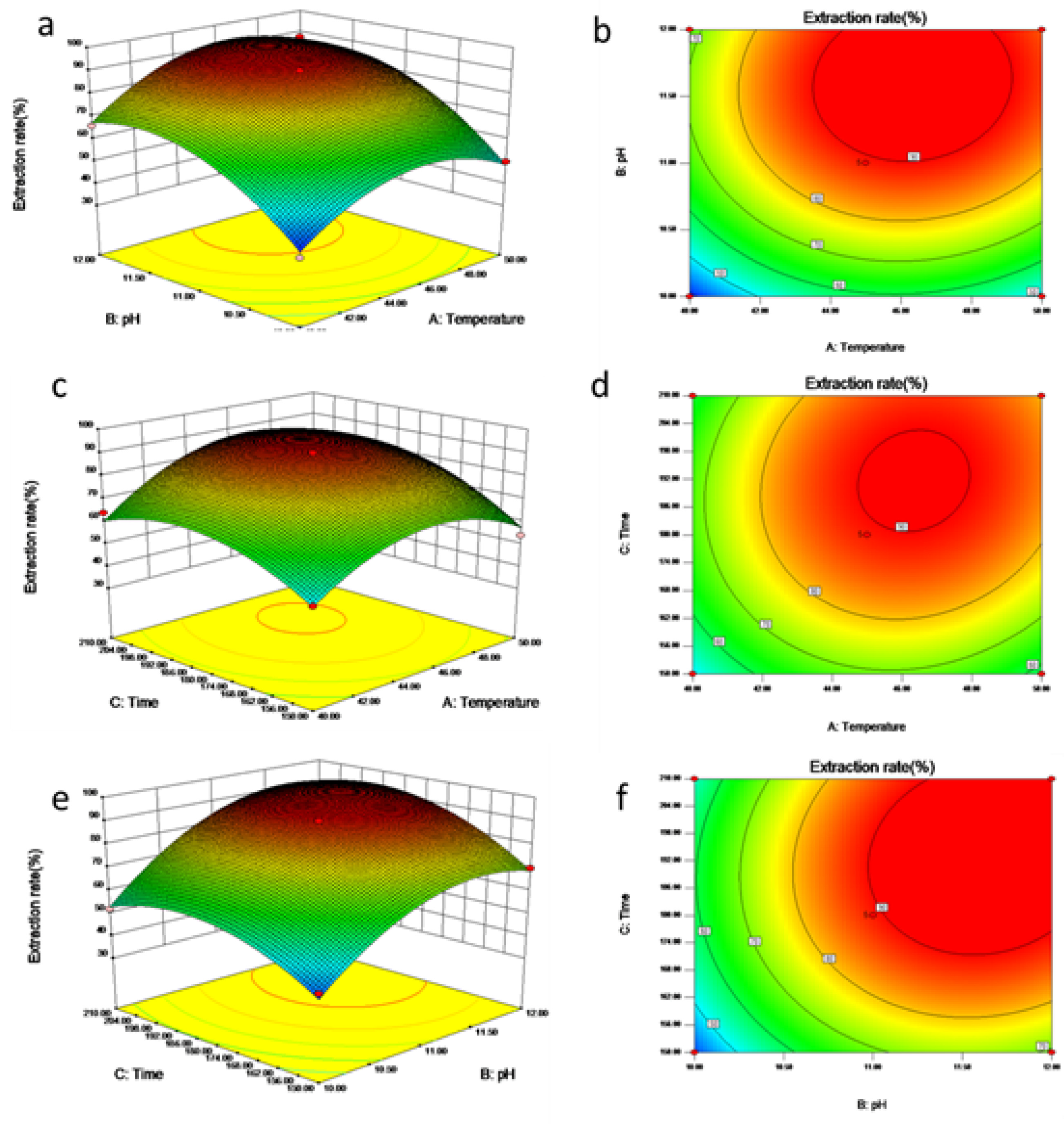

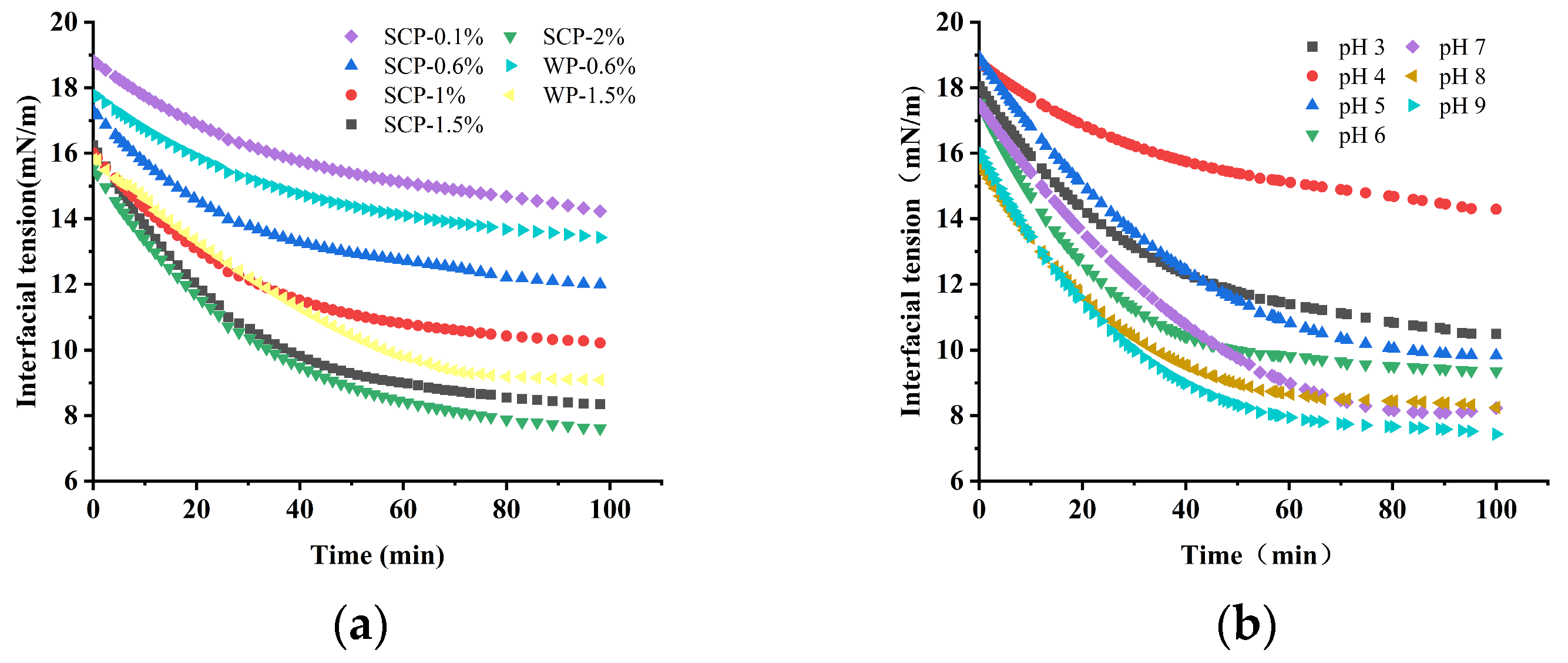
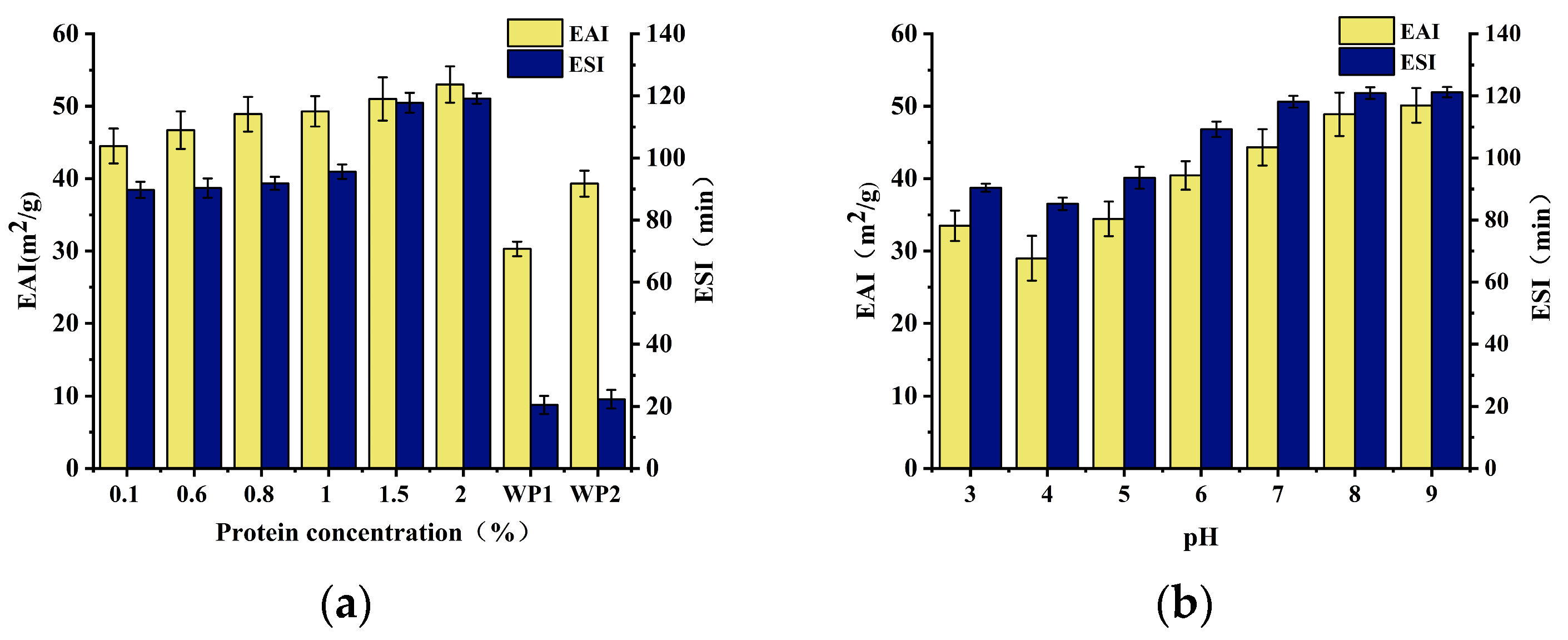
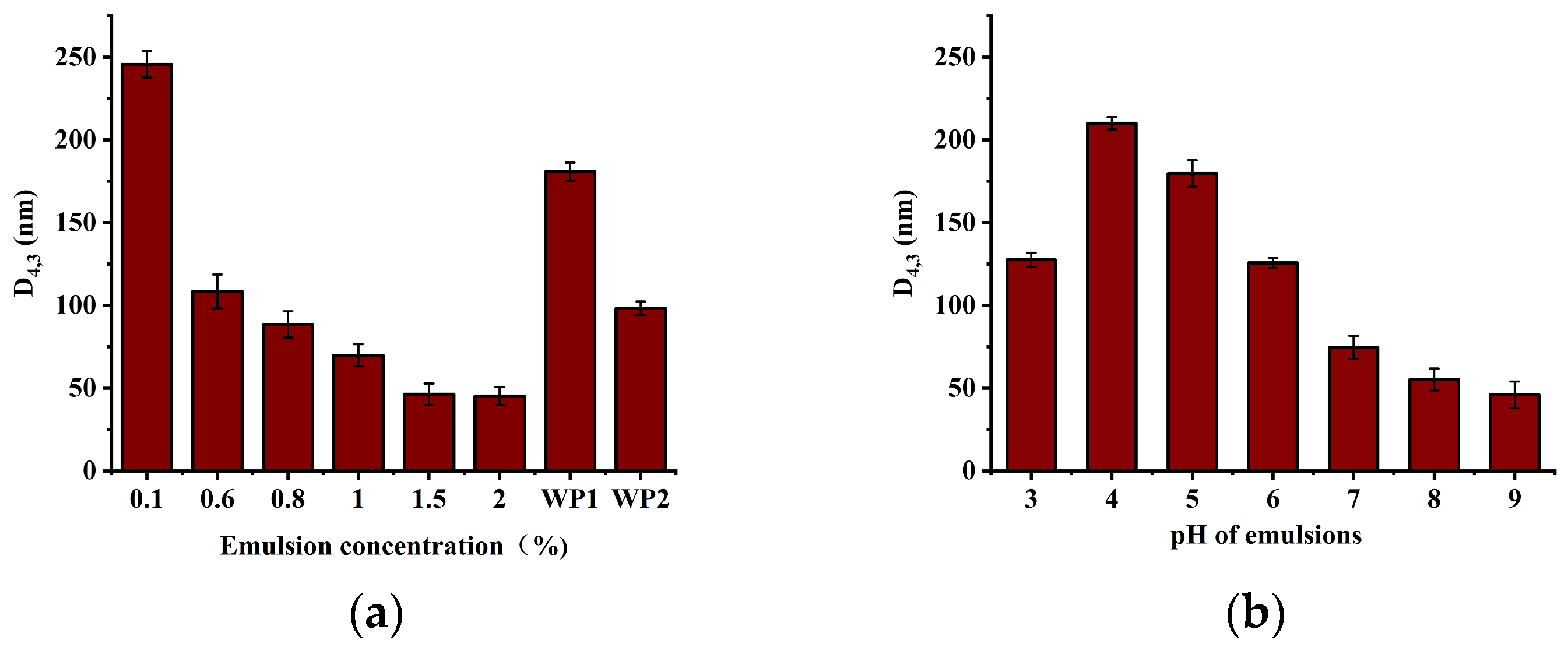
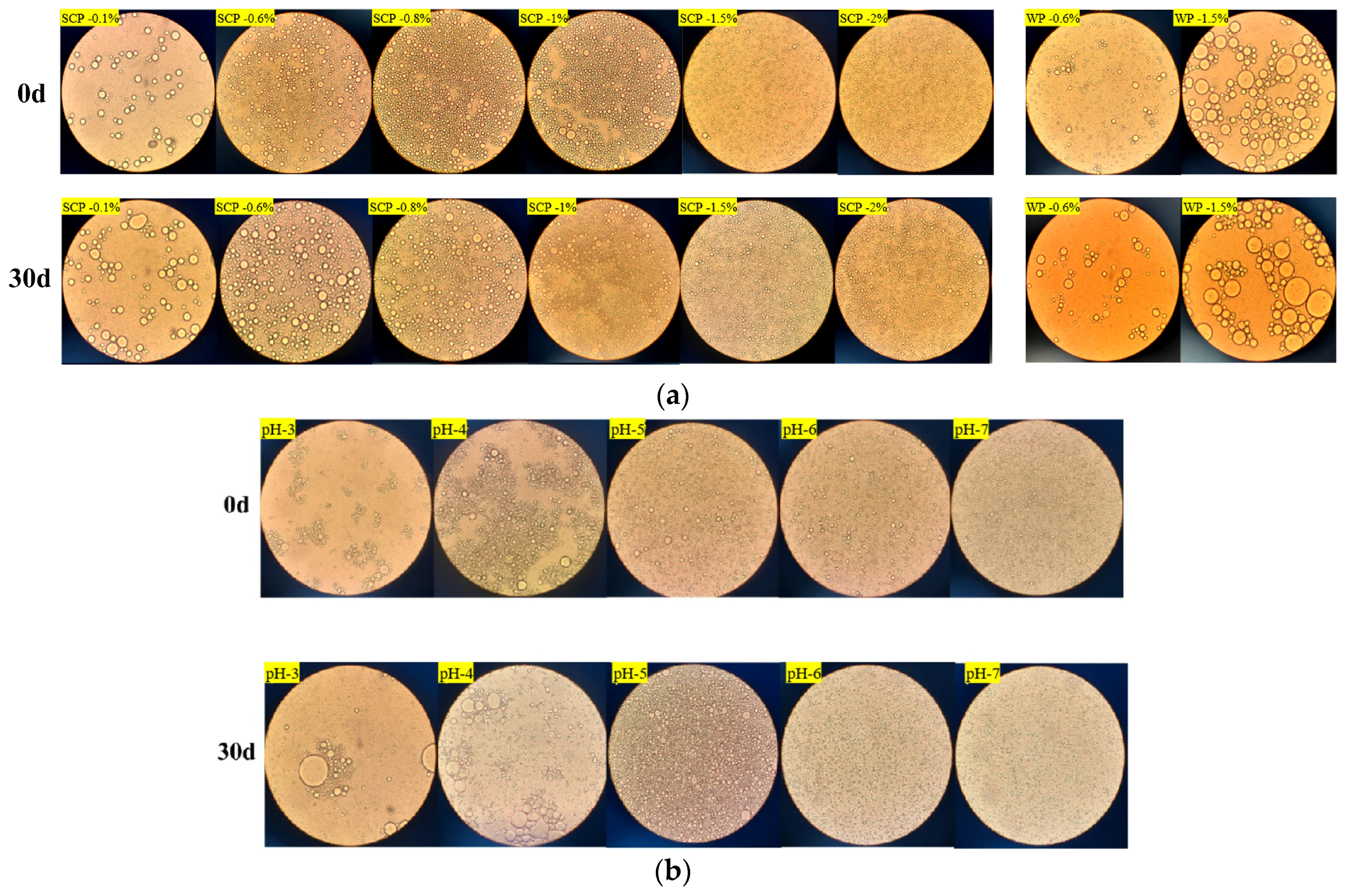
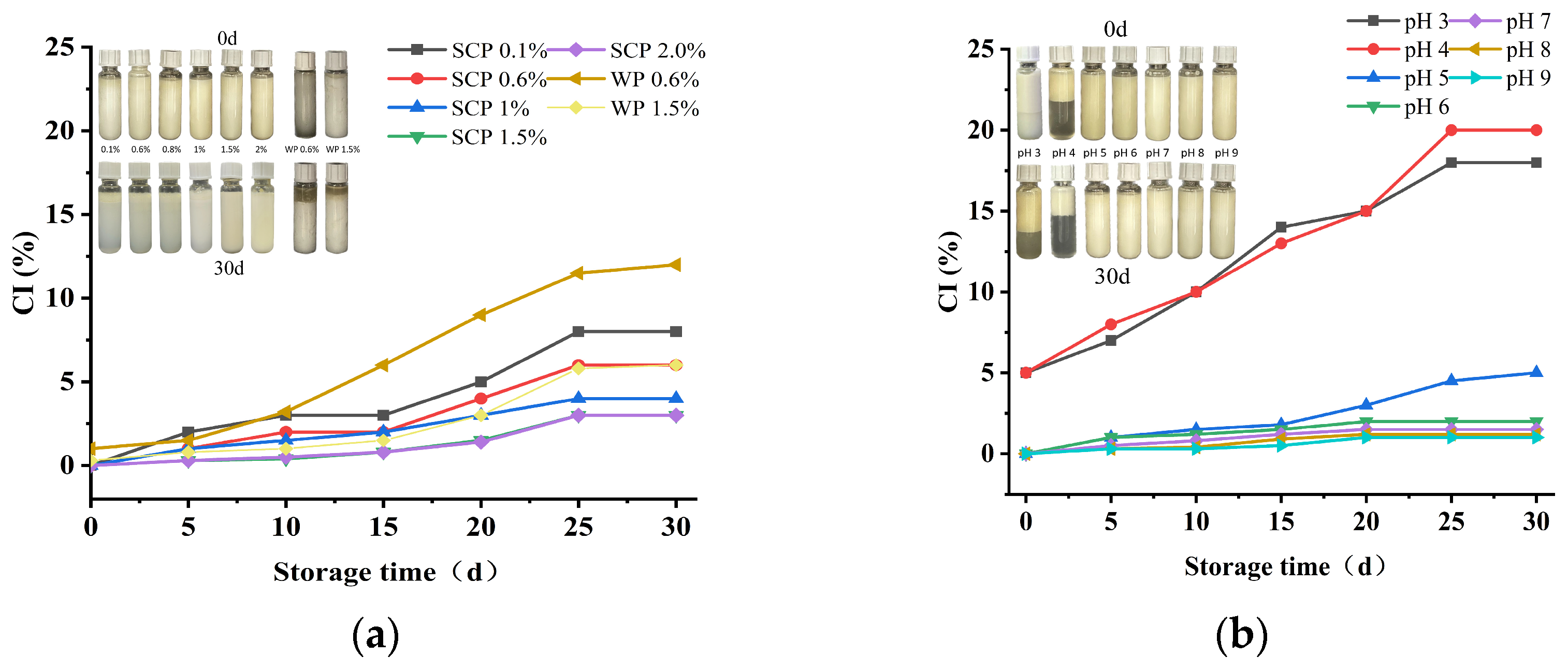
| Levels | Factors | ||
|---|---|---|---|
| −1 | 0 | 1 | |
| A: Temperature (°C) | 40 | 45 | 50 |
| B: pH | 10 | 11 | 12 |
| C: Time (min) | 150 | 180 | 210 |
| Levels No. | Factors | Extraction Rate (%) | ||
|---|---|---|---|---|
| A-Temperature | B-pH | C-Time | ||
| 1 | 50 | 12 | 150 | 87.5 |
| 2 | 45 | 11 | 180 | 85 |
| 3 | 45 | 12 | 150 | 70 |
| 4 | 45 | 10 | 210 | 52 |
| 5 | 50 | 11 | 210 | 80 |
| 6 | 45 | 11 | 180 | 90 |
| 7 | 50 | 10 | 180 | 50 |
| 8 | 40 | 11 | 210 | 64 |
| 9 | 45 | 11 | 180 | 90 |
| 10 | 40 | 12 | 180 | 66 |
| 11 | 40 | 10 | 180 | 36 |
| 12 | 45 | 11 | 180 | 90 |
| 13 | 45 | 10 | 150 | 43 |
| 14 | 40 | 11 | 150 | 43.6 |
| 15 | 45 | 12 | 150 | 70 |
| 16 | 45 | 11 | 180 | 90 |
| 17 | 50 | 11 | 150 | 54 |
| Origin | Quadratic Sum | Degree of Freedom | Mean Square | F Value | Prob |
|---|---|---|---|---|---|
| Source | SS | DF | MS | F | >F |
| Models | 5797.37 | 9 | 644.15 | 61.19 | <0.0001 |
| A—Temperature | 385.03 | 1 | 385.03 | 36.58 | <0.0001 |
| B—pH | 2128.78 | 1 | 2128.78 | 202.23 | <0.0001 |
| C—Time | 561.13 | 1 | 561.13 | 53.30 | <0.0001 |
| AB | 14.06 | 1 | 14.06 | 1.34 | 0.0002 |
| AC | 36.00 | 1 | 36.00 | 3.42 | 0.1069 |
| BC | 20.25 | 1 | 20.25 | 1.92 | 0.2080 |
| A2 | 971.20 | 1 | 971.20 | 92.26 | <0.0001 |
| B2 | 817.91 | 1 | 817.91 | 77.70 | <0.0001 |
| C2 | 587.52 | 1 | 587.52 | 55.81 | <0.0001 |
| Residual | 53.69 | 7 | 7.21 | ||
| Lack of fit | 53.69 | 3 | 12.48 | 3.58 | 0.1249 |
| Pure error | 13.01 | 4 | 3.25 | ||
| Synthesized | 5871.06 | 16 |
| Protein | Emulsifying Activity (EAI) | Emulsion Stability (ESI) (min) |
|---|---|---|
| SCP | 49 ± 3 | 120.85 ± 5 |
| WP | 39.85 ± 1.2 | 22.38 ± 3.2 |
Disclaimer/Publisher’s Note: The statements, opinions and data contained in all publications are solely those of the individual author(s) and contributor(s) and not of MDPI and/or the editor(s). MDPI and/or the editor(s) disclaim responsibility for any injury to people or property resulting from any ideas, methods, instructions or products referred to in the content. |
© 2024 by the authors. Licensee MDPI, Basel, Switzerland. This article is an open access article distributed under the terms and conditions of the Creative Commons Attribution (CC BY) license (https://creativecommons.org/licenses/by/4.0/).
Share and Cite
Yang, Y.; Zhao, X.; Liu, L.; Wang, X.; Li, R.; Zhang, J. Optimizing the Extraction of Protein from Defatted Schizochytrium Cell Residues and Studying the Emulsification Characteristics of Protein. Fermentation 2024, 10, 416. https://doi.org/10.3390/fermentation10080416
Yang Y, Zhao X, Liu L, Wang X, Li R, Zhang J. Optimizing the Extraction of Protein from Defatted Schizochytrium Cell Residues and Studying the Emulsification Characteristics of Protein. Fermentation. 2024; 10(8):416. https://doi.org/10.3390/fermentation10080416
Chicago/Turabian StyleYang, Yingying, Xiangying Zhao, Liping Liu, Xinyu Wang, Ruiguo Li, and Jiaxiang Zhang. 2024. "Optimizing the Extraction of Protein from Defatted Schizochytrium Cell Residues and Studying the Emulsification Characteristics of Protein" Fermentation 10, no. 8: 416. https://doi.org/10.3390/fermentation10080416





